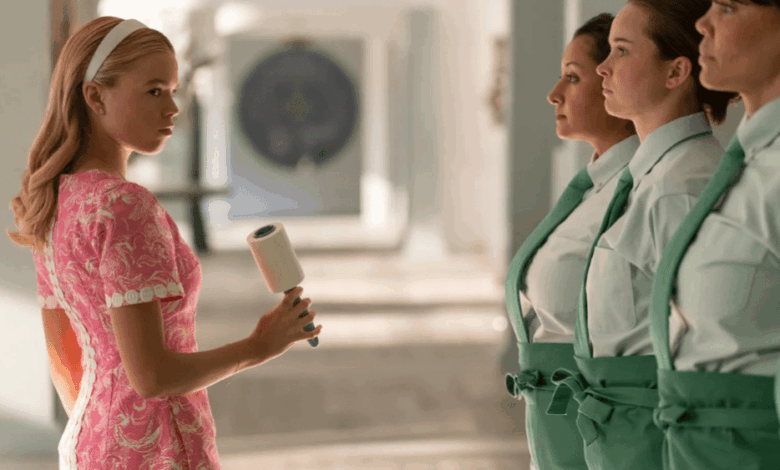‘Sirens’ Creator Molly Smith Metzler Breaks Down Series Finale

Netflix’s new series “Sirens” is making waves with its dark comedy and intriguing storyline. The show, adapted from Molly Smith Metzler’s play “Elemeno Pea,” follows Devon, a blue-collar New Yorker who visits her sister Simone at the luxurious estate owned by Simone’s boss, Michaela. As Devon uncovers the strange and cult-like behavior at the estate, she becomes determined to free her sister from the clutches of Michaela and her husband Peter.
Throughout the series, Devon navigates the treacherous world of the coastal elite, uncovering a sordid affair from the past and racing against time to save her sister. The show explores themes of power, manipulation, and the blurred lines between hero and villain.
In a recent interview with Variety, creator Molly Smith Metzler discussed the cyclical nature of the series and the significance of the title “Sirens.” Drawing inspiration from Greek mythology, the show delves into the roles of the women in the story and the traps they find themselves in.
One of the key characters in the series is Peter, played by Kevin Bacon. Metzler revealed that casting Bacon was an easy decision, as he brought warmth and humility to the role of Peter. Despite his power and influence, Peter is portrayed as a complex character struggling with his own desires for love and family.
The ending of the series leaves viewers questioning the true nature of Simone and whether she is a hero or a villain in her own story. Metzler intentionally crafted an ambiguous final shot of Simone on the cliffside, inviting viewers to interpret her emotions and intentions.
Overall, “Sirens” is a gripping and thought-provoking series that explores the darker side of wealth and power. With its complex characters and intriguing storyline, the show is sure to keep audiences on the edge of their seats until the very end.
Is it fair, the people we cast in the roles of “monster” in our lives? Are we villains? Are they? What is a monster, really? These are questions that often come to mind when we think about the relationships we have with others. In the new series “Sirens,” based on the play “Elemeno Pea,” these questions are explored through the complex dynamics of the characters.
The play “Elemeno Pea” is a five-character, 90-minute play that takes place in one room – the guest house. The characters include Michaela, Simone, Devon, Ethan, and Jose. The core cast from the play remains intact in the series, but the world they inhabit expands significantly. The vibrant visuals of the cliff, the island, and other elements bring the story to life in a new way.
One of the key elements that was expanded upon in the series was the introduction of new characters, such as Peter, Devon and Simone’s father. These additions added depth and complexity to the storyline, providing a richer understanding of the characters and their relationships.
When it comes to casting, the choice of Milly Alcock as Simone was crucial. Simone is a character who holds many secrets and complexities, and Alcock’s performance captures the nuances of the role perfectly. The audience is kept guessing and trying to figure her out, which adds to the intrigue of the series.
Devon’s storyline, which revolves around the strain of taking care of her father, is inspired by real-life struggles faced by many individuals. The class gap and wage gap in society play a significant role in Devon’s challenges, highlighting the importance of addressing these issues in a thoughtful and meaningful way.
The title of the series, “Sirens,” holds a double meaning that adds depth to the overall narrative. The sisters have a code word – “Sirens” – which signifies a call for help or support. This word carries both a literal and metaphorical significance, reflecting the complexities of the relationships within the series.
In conclusion, “Sirens” delves into the complexities of human relationships, exploring themes of identity, family, and societal expectations. Through its rich character development and thought-provoking storytelling, the series challenges viewers to question their perceptions of monsters and villains, ultimately blurring the lines between right and wrong.
In a serendipitous turn of events, a new story idea landed in my lap, something that never happens to a writer. It was a moment of inspiration that just coalesced out of thin air, and I knew I had to run with it.
The origin of the catchphrase “Hey hey” in my story stems from my observations during summers spent at Martha’s Vineyard. Working at the Yacht Club, I noticed how people there picked up each other’s mannerisms and ways of speaking. It was like a contagion, with one person introducing a new phrase or trend that quickly spread to everyone else. In my mind, the characters Michaela and Simone just started saying “Hey hey” to each other one day, and it became their signature greeting. It was a small detail that added depth to their relationship.
Another interesting element in the story is the nickname Jose gives to Michaela – “Mi Amor.” This term of endearment has its roots in the original play and serves as a reminder of Jose’s power within the narrative. Despite appearing subservient to Michaela, Jose holds a position of authority and knowledge that sets him apart.
The lockets worn by the “sirens” in the story are a symbol of status and belonging within the elite circles of Nantucket Island. These lockets, known as basket necklaces, are handmade and exclusive to the area. They represent a sense of arrival and membership in a select group. While there are no drugs hidden inside them, the lockets hold a significance akin to a religious symbol, hinting at a deeper connection among the characters.
One recurring motif in the story is Michaela’s fascination with birds, particularly her involvement with the Folger Wildlife Preservation Society. This fascination ties back to the original portrayal of sirens in Greek mythology as half-bird, half-woman creatures. Birds symbolize both beauty and danger, mirroring the complex nature of the sirens themselves. For Michaela, caring for birds serves as a way to nurture and protect something vulnerable, reflecting her own sense of being a rare and unique individual.
Overall, the story weaves together themes of power, status, and mythology in a captivating narrative that keeps readers engaged. It’s a tale of secrets, hidden motives, and the allure of the unknown, all set against the backdrop of a prestigious island community. As the characters navigate their relationships and ambitions, the true nature of the sirens begins to emerge, revealing a darker and more complex reality beneath the surface.
This interview has been edited and condensed for clarity, offering a glimpse into the creative process behind the story and the inspirations that drive its development. With its rich tapestry of characters and themes, “Sirens” promises to be a compelling and thought-provoking exploration of human nature and the mysteries that lie within us all.





